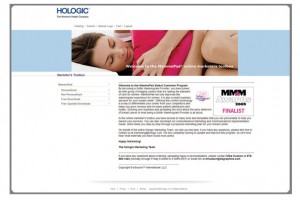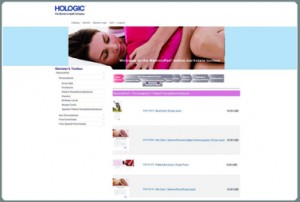On-Demand Print and Fulfillment Supply Chain Solutions
CHALLENGE
 Large medical device company seeking cost effective supply chain solutions
Large medical device company seeking cost effective supply chain solutions
Hologic, a leading manufacturer and supplier of diagnostic, surgical, and medical imaging equipment and products relating to women’s health, was seeking a supply chain solution. They were looking for a completely integrated, easy-to-use online interface for their doctors and hospitals to order product literature and marketing materials. As the company contunued to grown in size, with multiple product lines added, they needed a quick and easy way to respond to daily customer requests.
SOLUTION
Web 2 print and fulfillment supply chain solution
 Our supply chain solution was to develop a fully automated online inventory and management storefront connecting to our robust 24–7 print and fulfillment facility. The service was only available to existing clients and was made product-specific based upon password and user permissions. Registration for an account was made easy and a user name and password were sent within 24 hours. It was important to make the ordering process both simple and quick. Additionally, Hologic’s customers needed the ability to customize their materials with personalized information for their individual facilities. The site was based on shopping cart technology, including customer credit card and purchase order-invoice processing. Hologic’s branding elements were incorporated and the site was fast and intuitive to navigate. Customers could browse for products and view PDFs during the ordering process. Once an order was placed, emailed confirmations are automatically sent, and within 48 hours orders are shipped and tracking information sent.
Our supply chain solution was to develop a fully automated online inventory and management storefront connecting to our robust 24–7 print and fulfillment facility. The service was only available to existing clients and was made product-specific based upon password and user permissions. Registration for an account was made easy and a user name and password were sent within 24 hours. It was important to make the ordering process both simple and quick. Additionally, Hologic’s customers needed the ability to customize their materials with personalized information for their individual facilities. The site was based on shopping cart technology, including customer credit card and purchase order-invoice processing. Hologic’s branding elements were incorporated and the site was fast and intuitive to navigate. Customers could browse for products and view PDFs during the ordering process. Once an order was placed, emailed confirmations are automatically sent, and within 48 hours orders are shipped and tracking information sent.
RESULT
Improved efficiency, reduced waste and lowered costs
Hologic’s customers and sales channels could now order the most up-to-date collateral and training materials in just the quantities needed. Production costs were lowered by eliminating print overruns and obsolete literature, while the time and cost of program administration was significantly reduced.







